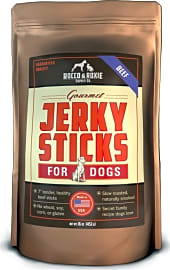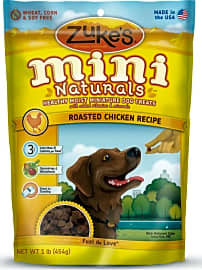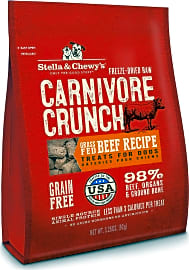The 10 Best Healthy Dog Treats

This wiki has been updated 41 times since it was first published in October of 2015. Some of these healthy and natural dog treats look tasty enough for humans to eat, though we wouldn't recommend it unless you want to get into a growling match with your pup. But for pooches who have sensitive stomachs, allergies, or restricted diets, they are a good option, and ideal for anyone who believes their pets should eat as well as they do. When users buy our independently chosen editorial selections, we may earn commissions to help fund the Wiki.
Editor's Notes
February 13, 2020:
This list was crafted and is maintained with your pet's well-being in mind. We only included top-tier selections made in the USA or North America by responsible companies using quality ingredients from trusted sources.
None of the companies on this list have had a recent recall, and of the few that have had recalls at all in the last decade, they have been voluntary due to small concerns to ensure pet safety. We also want to point out that while some of the picks on this list are grain free thanks to the recent push for pet foods to eliminate it from their formulas, excluding grain entirely from your dog's diet can result in heart issues down the line.
It's best to dispense treats sparingly and rotate them often with other natural treats like apple, carrots, sugar-free yogurt, and blueberries to keep things varied and interesting.
Today we said goodbye to Plato Pet due to reports of inconsistent quality and added Nutro Natural Crunchy in its stead. These little morsels are low-calorie and easy to carry around in a pocket without stinking up your clothes or falling apart, making them great for training on walks. We also removed Pet Eden Sweet Potato in favor of the more compelling Natural Balance L.I.D., which are easily digestible and boast limited ingredients so as not to cause stomach issues.
Above all, our priority when updating this list was safety. After that, reliable companies, quality, human-grade ingredients, minimal amounts of additives and preservatives, taste, and price helped us choose some of the best offerings out there. Please always read packaging thoroughly to ensure you have chosen the right treat for your breed's size and age, as well as for doling out the correct portions. If you're shopping for a young dog, some of the treats on this list are appropriate, or else consider checking out our list written specifically for puppies.
Special Honors
Just Food For Dogs Beef Brisket Treats These savory treats are made from 100% real USDA-certified beef brisket. Each piece is slow-cooked, sliced, and packaged in one of the company's Southern California kitchens. They are baked and dehydrated without the use of chemicals and once opened, the only preservative is the refrigerator. They contain no growth hormones or artificial coloring and the packaging is BPA-free. justfoodfordogs.com
How Can You Tell If A Dog Treat Is Healthy?
You're probably not doing the dog any favors if the answer is a no.
A dog doesn't care if a treat has any nutrients. A dog only cares if a treat tastes really good. And so it is up to you, the owner, to decide upon a treat that your dog will not only benefit from, but enjoy.
There are a plethora of dog treats on the market, and - much like human food - one of the keys to choosing a great treat comes down to understanding what makes up a healthy diet, and how to spot it. By and large, you'll want a treat that is high in protein (unless your dog is on a low-protein diet), and you'll also want a treat that is rich in vitamins and beta-carotene (for maintaining healthy skin and eyes).
A dog treat should be soft and chewable and contain calcium for maintaining strong teeth. One that contains fiber for promoting regular bowel movements (and low cholesterol) and one that isn't pumped with additives, or cooked in grease is a smart choice.
You'll want to read a treat's ingredient label to determine whether that treat is made of meat, and whether that meat is actually real or artificial. You can also use the ingredient label to determine whether a treat is low in fat, gluten-free, or whether it contains salt or sugar. While reading these labels, be sure to keep an eye out for any disclaimers or warnings. In addition, it's helpful to take note of what the manufacturer considers one serving, or portion.
The most important test of any dog treat is to observe how your dog responds to it. Does the dog seem sluggish, or upbeat? Are his stools more solid, or watery? Above all else, does the dog seem excited whenever you offer him a treat? You're probably not doing the dog any favors if the answer is a no.
A Brief History of The Dog Treat As A Reward
Believe it or not, a dog treat is based on the same basic operating principle as one of the most renowned behavioral experiments of all time. In that experiment, a Russian physiologist named Ivan Pavlov focused on the idea of classical conditioning - that is, evoking a predictable response based on the introduction of some repetitive reward, or corresponding stimulus.
You can use this approach to both encourage and discourage recurring behaviors.
In the case of what has since become known as Pavlov's Dog, Pavlov noticed that pooches of varying breeds began to salivate upon seeing a technician - or hearing a bell - that they had been conditioned to associate with food. The conclusion, which has since provided the impetus for innumerable psychological experiments, was that a dog's behavior could be altered by simply introducing the possibility of a reward.
Scientifically speaking, dog treats operate according to the same guiding premise. The key as an owner is to let your dog know what he or she earned each treat for. If you're teaching a dog how to walk up stairs, for example, you can start by rewarding that dog with a treat immediately after he has ascended one stair. As you start to see some success, stretch it out by offering the dog a treat once every two stairs ... three stairs ... three-and-a-half stairs, then four. Over time, your dog will be able to ascend an entire flight of stairs almost effortlessly. Once that occurs, you can begin to ween him off the expectation of a reward.
You can use this approach to both encourage and discourage recurring behaviors. The key, according to Pavlov's findings, is that the reward needs to be offered at the exact moment the desired behavior occurs. The more time that elapses between the behavior and the treat, the more confused a dog will become about what actually triggered the reward.
Why Does a Dog Get More Excited Over a Treat Than Its Regular Food?
There is no evidence to support the notion that any dog prefers the taste of a treat to its regular canned food. What a dog is responding to just prior to being given a treat is the prospect of what it believes to be a reward (see above).
Any owner who deprives his pet of these meals is neglectful, to say the least.
Think of it like this; a parent calls a child to dinner, and the child arrives at the table without a word. Once the parent mentions the possibility of going out to get ice cream for dessert, however, the child perks up. Why is that? Psychologically, it's because the child knows that ice cream is a sugary treat, and the child also knows that a trip to the ice cream parlor is a reflection of his good behavior.
To a dog, there is breakfast, and there is dinner. Any owner who deprives his pet of these meals is neglectful, to say the least. A treat, on the other hand, remains something unpredictable; something to be earned, and then savored.
Consider a recent study conducted by the University of Agricultural Studies in Sweden. This study was conducted by splitting 12 beagles into two equal groups. One group of beagles was led into a treat room, where each dog was conditioned to perform a specific task before earning a treat as a reward. The other group of beagles was subsequently led into the same room, where each dog was given a treat without being made to work for it at all.
The study found that the conditioned group of beagles began to get excited whenever being led back into the "treat room" after their first time. More importantly, these trained dogs would actually insist on repeating the reinforced tasks before accepting another treat as a reward. The "untrained" group of beagles, on the other hand, showed no excitement upon being led back into the treat room, and these dogs showed little recognition that being given a treat was actually meant to be a reward.















